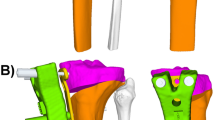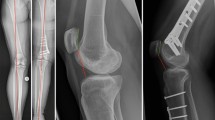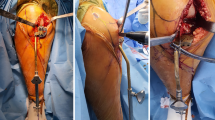Abstract
Purpose
Patellofemoral instability can be caused by tibial or femoral torsional deformity. Established surgical treatment options are rotational osteotomies, but the transfer from pre-operative planning to surgical execution can be challenging. Patient-specific instruments (PSI) are proofed to be helpful tools in realignment surgery. However, accuracy of PSI in femoral and tibial rotational osteotomies remains still unknown. Goal of the present study was to evaluate the accuracy of PSI in femoral and tibial rotational osteotomies in a patient population suffering from patellofemoral instability.
Methods
All patients that underwent femoral or tibial rotational osteotomy using PSI in case of patellofemoral instability from October 2015 until April 2019 in our clinic were included. Twelve knees with twelve supracondylar femoral and seven supratuberositary tibial rotational osteotomies could be included. Accuracy of the correction was assessed using pre- and post-operative CT scans based on conventional measurements and, in 3D, based on 3D bone models of the respective patients.
Results
CT measurements revealed an absolute difference between planned and achieved rotation of 4.8° ± 3.1° for femoral and 7.9° ± 3.7° for tibial rotational osteotomies without significant difference (p = 0.069). Regarding 3D assessment, a significant difference could be observed for the residual error between femoral and tibial rotational osteotomies in the 3D angle (p = 0.014) with a higher accuracy for the femoral side.
Conclusion
The application of PSI for femoral and tibial rotational osteotomy is a safe surgical treatment option. Accuracy for femoral rotational osteotomies is higher compared with tibial rotational osteotomies using PSI.




Similar content being viewed by others
References
Hinterwimmer S, Rosenstiel N, Lenich A, Waldt S, Imhoff AB (2012) Femoral osteotomy for patellofemoral instability. Unfallchirurg 115(5):410–416. https://doi.org/10.1007/s00113-012-2198-8
Nelitz M, Dreyhaupt J, Williams SR, Dornacher D (2015) Combined supracondylar femoral derotation osteotomy and patellofemoral ligament reconstruction for recurrent patellar dislocation and severe femoral anteversion syndrome: surgical technique and clinical outcome. Int Orthop 39(12):2355–2362. https://doi.org/10.1007/s00264-015-2859-7
Drexler M, Dwyer T, Dolkart O, Goldstein Y, Steinberg EL, Chakravertty R, Cameron JC (2014) Tibial rotational osteotomy and distal tuberosity transfer for patella subluxation secondary to excessive external tibial torsion: surgical technique and clinical outcome. Knee surgery, sports traumatology, arthroscopy : official journal of the ESSKA 22(11):2682–2689. https://doi.org/10.1007/s00167-013-2561-5
Imhoff FB, Cotic M, Liska F, Dyrna FGE, Beitzel K, Imhoff AB, Herbst E (2019) Derotational osteotomy at the distal femur is effective to treat patients with patellar instability. Knee surgery, sports traumatology, arthroscopy : official journal of the ESSKA 27(2):652–658. https://doi.org/10.1007/s00167-018-5212-z
Lee SY, Jeong J, Lee K, Chung CY, Lee KM, Kwon SS, Choi Y, Kim TG, Lee JI, Lee J, Park MS (2014) Unexpected angular or rotational deformity after corrective osteotomy. BMC Musculoskelet Disord 15:175. https://doi.org/10.1186/1471-2474-15-175
Nelitz M, Wehner T, Steiner M, Durselen L, Lippacher S (2014) The effects of femoral external derotational osteotomy on frontal plane alignment. Knee surgery, sports traumatology, arthroscopy : official journal of the ESSKA 22(11):2740–2746. https://doi.org/10.1007/s00167-013-2618-5
Imhoff FB, Scheiderer B, Zakko P, Obopilwe E, Liska F, Imhoff AB, Mazzocca AD, Arciero RA, Beitzel K (2017) How to avoid unintended valgus alignment in distal femoral derotational osteotomy for treatment of femoral torsional malalignment - a concept study. BMC Musculoskelet Disord 18(1):553. https://doi.org/10.1186/s12891-017-1904-7
Jud L, Vlachopoulos L, Haller TV, Fucentese SF, Rahm S, Zingg PO (2020) The impact of mal-angulated femoral rotational osteotomies on mechanical leg axis: a computer simulation model. BMC musculoskeletal disorders 21 (1):50. https://doi.org/10.1186/s12891-020-3075-1
Jacquet C, Chan-Yu-Kin J, Sharma A, Argenson JN, Parratte S, Ollivier M (2018) More accurate correction using “patient-specific” cutting guides in opening wedge distal femur varization osteotomies. Int Orthop. https://doi.org/10.1007/s00264-018-4207-1
Munier M, Donnez M, Ollivier M, Flecher X, Chabrand P, Argenson JN, Parratte S (2017) Can three-dimensional patient-specific cutting guides be used to achieve optimal correction for high tibial osteotomy? Pilot study. Orthopaedics & traumatology, surgery & research : OTSR 103(2):245–250. https://doi.org/10.1016/j.otsr.2016.11.020
Shi J, Lv W, Wang Y, Ma B, Cui W, Liu Z, Han K (2019) Three dimensional patient-specific printed cutting guides for closing-wedge distal femoral osteotomy. Int Orthop 43(3):619–624. https://doi.org/10.1007/s00264-018-4043-3
Waidelich HA, Strecker W, Schneider E (1992) Computed tomographic torsion-angle and length measurement of the lower extremity. The methods, normal values and radiation load. RoFo : Fortschritte auf dem Gebiete der Rontgenstrahlen und der Nuklearmedizin 157(3):245–251. https://doi.org/10.1055/s-2008-1033007
Goutallier D, Van Driessche S, Manicom O, Sariali E, Bernageau J, Radier C (2006) Influence of lower-limb torsion on long-term outcomes of tibial valgus osteotomy for medial compartment knee osteoarthritis. J Bone Joint Surg Am 88(11):2439–2447. https://doi.org/10.2106/JBJS.E.01130
Vlachopoulos L, Schweizer A, Graf M, Nagy L, Fürnstahl P (2015) Three-dimensional postoperative accuracy of extra-articular forearm osteotomies using CT-scan based patient-specific surgical guides. BMC Musculoskelet Disord 16:336. https://doi.org/10.1186/s12891-015-0793-x
Murase T, Oka K, Moritomo H, Goto A, Yoshikawa H, Sugamoto K (2008) Three-dimensional corrective osteotomy of malunited fractures of the upper extremity with use of a computer simulation system. J Bone Joint Surg Am 90(11):2375–2389. https://doi.org/10.2106/JBJS.G.01299
Schweizer A, Fürnstahl P, Harders M, Szekely G, Nagy L (2010) Complex radius shaft malunion: osteotomy with computer-assisted planning. Hand (N Y) 5(2):171–178. https://doi.org/10.1007/s11552-009-9233-4
Wu G, Siegler S, Allard P, Kirtley C, Leardini A, Rosenbaum D, Whittle M, D'Lima DD, Cristofolini L, Witte H, Schmid O, Stokes I, Standardization, Terminology Committee of the International Society of B (2002) ISB recommendation on definitions of joint coordinate system of various joints for the reporting of human joint motion--part I: ankle, hip, and spine. International Society of Biomechanics. J Biomech 35 (4):543–548
Schneider P, Eberly DH (2002) Geometric tools for computer graphics. MorganKaufmann
Fürnstahl P, Schweizer A, Graf M, Vlachopoulos L, Fucentese S, Wirth S, Nagy L, Szekely G, Goksel O (2016) Surgical treatment of long-bone deformities: 3D preoperative planning and patient-specific instrumentation. Computational radiology for orthopaedic interventions. Springer, New York, pp 123–149
Landis JR, Koch GC (1977) The measurement of observer agreement for categorical data. Biometrics 33:159–174
Fiz N, Delgado D, Sanchez X, Sanchez P, Bilbao AM, Oraa J, Sanchez M (2017) Application of 3D technology and printing for femoral derotation osteotomy: case and technical report. Annals of translational medicine 5 (20):400. Doi:https://doi.org/10.21037/atm.2017.07.03
Dobbe JG, Pre KJ, Kloen P, Blankevoort L, Streekstra GJ (2011) Computer-assisted and patient-specific 3-D planning and evaluation of a single-cut rotational osteotomy for complex long-bone deformities. Medical & biological engineering & computing 49(12):1363–1370. https://doi.org/10.1007/s11517-011-0830-3
Kolp D, Ziebarth K, Slongo T (2017) Rotation or derotation osteotomy of the tibia. Operative Orthopadie und Traumatologie 29(2):163–172. https://doi.org/10.1007/s00064-016-0473-5
Rattey T, Hyndman J (1994) Rotational osteotomies of the leg: tibia alone versus both tibia and fibula. J Pediatr Orthop 14(5):615–618. https://doi.org/10.1097/01241398-199409000-00012
Ryan DD, Rethlefsen SA, Skaggs DL, Kay RM (2005) Results of tibial rotational osteotomy without concomitant fibular osteotomy in children with cerebral palsy. J Pediatr Orthop 25(1):84–88. https://doi.org/10.1097/00004694-200501000-00019
Schroter S, Ihle C, Elson DW, Dobele S, Stockle U, Ateschrang A (2016) Surgical accuracy in high tibial osteotomy: coronal equivalence of computer navigation and gap measurement. Knee surgery, sports traumatology, arthroscopy : official journal of the ESSKA 24(11):3410–3417. https://doi.org/10.1007/s00167-016-3983-7
Author information
Authors and Affiliations
Corresponding author
Ethics declarations
Conflict of interest
All authors declare that they have no conflict of interest.
Ethical approval
The local ethical committee approved this study (Zurich Cantonal Ethics Committee, KEK 2018–02242) and all patients gave their informed consent for their participation in and the publication of this study.
Additional information
Publisher’s note
Springer Nature remains neutral with regard to jurisdictional claims in published maps and institutional affiliations.
Rights and permissions
About this article
Cite this article
Jud, L., Vlachopoulos, L., Beeler, S. et al. Accuracy of three dimensional-planned patient-specific instrumentation in femoral and tibial rotational osteotomy for patellofemoral instability. International Orthopaedics (SICOT) 44, 1711–1717 (2020). https://doi.org/10.1007/s00264-020-04496-y
Received:
Accepted:
Published:
Issue Date:
DOI: https://doi.org/10.1007/s00264-020-04496-y




